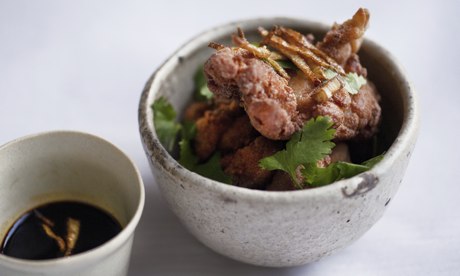
Fried ginger chicken, yuzu dip.
Photograph: Jonathan Lovekin for Observer Food Monthly
Ingredients come and go, but in the past couple of years, a handful of new
ones have taken up a permanent place in my kitchen. This last year, five
ingredients, spice mixes and flavourings made the leap from "fun things to play
with" to a much-loved part of my everyday cooking. They include a soft fragrant
spice mix; a startling fruit; a blend of herbs and seeds; and a seasoning that
is hot and sweet. There is also a fresh ingredient whose flavour is difficult to
pin down.
Some of these are available from high-street supermarkets, others from ethnic food shops and almost all are available online. They are all well established within their own cuisines, but haven't, till now, been easy to find in UK shops. Many of them may be already in regular use in your kitchen. But all are recent additions to my cooking that I believe deserve a much wider audience.
Buy it for sharpening up a marinade; adding a deep citrus flavour to soy sauce-based dips for tempura or sushi.
Get it from Japanese food shops. (It is rather expensive,
but a little goes a long way.)
Serves 2
for the marinade:
light soy sauce 75ml
mirin 125ml
fresh ginger grated, 3 tbsp
chicken drumsticks 6
ginger a thumb-sized knob
rice flour 6 tbsp
for the dipping sauce:
dark soy sauce 2tbsp
yuzu juice 2 tbsp
oil for deep frying
Pour the light soy sauce into a sealable plastic bag, add the mirin and the freshly grated ginger.
Remove the skin from the drumsticks and slice the flesh from top to bottom to reveal the bone. Carefully cut the meat away from the bone in one piece and drop into the bag of marinade. Seal the bag and leave the chicken to soak in the seasoned soy and mirin for an hour or more. Overnight won't hurt.
Peel the thumb of ginger and cut into matchstick-size strips. Season the rice flour with salt and a little black pepper and spread it thickly on a plate or shallow bowl. Warm the oil to 180C.
Remove the chicken from its marinade and drop each piece into the seasoned rice flour, then lower carefully into the hot oil. Fry for 4 or 5 minutes until the outside is pale amber and lightly crisp. It is best not to overcrowd the pan, so cook them in two batches, and drain each on kitchen paper.
Fry the shredded ginger till golden and remove with a draining spoon. In a small bowl, mix the dark soy sauce and the yuzu juice together. Give the chicken a last quick fry to crisp it then serve with coriander leaves and the dipping sauce.
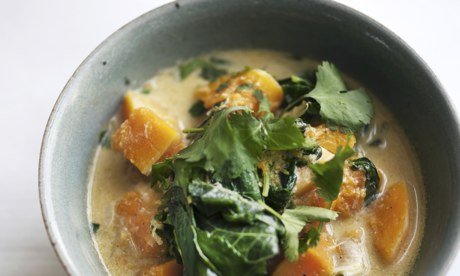 Butternut squash and coconut stew with
galangal. Photograph: Jonathan Lovekin for Observer Food Monthly
Galangal looks a little like ginger, but tastes very different, having none
of the root's citrus notes. Paler, smoother and often with pink tinges to its
plump ivory rhizomes, galangal is used in Vietnamese, Thai and Indonesian
cooking.
Butternut squash and coconut stew with
galangal. Photograph: Jonathan Lovekin for Observer Food Monthly
Galangal looks a little like ginger, but tastes very different, having none
of the root's citrus notes. Paler, smoother and often with pink tinges to its
plump ivory rhizomes, galangal is used in Vietnamese, Thai and Indonesian
cooking.
Buy it for adding to a Vietnamese curry; including in a marinade for beef or pork; or for clear fish soups with crab or prawns.
Get it from Chinese and south-east Asian food shops and some of the larger mainstream supermarkets.
Serves 4-6
butternut squash 600g
groundnut oil a little
coconut milk 400ml
stock 500ml
galangal peeled and grated 3tbsp
lime juice of ½
spring onions 3
assorted Asian greens 3 large handfuls
Thai basil a small handful
coriander a small handful
Peel the squash, discard any seeds and fibres and cut the flesh into small dice roughly 2cm square. Warm a little oil in a frying pan, add the cubes of squash and cook until lightly browned on all sides.
Pour in the coconut milk and stock and bring to the boil, then lower the heat to a simmer. Add the grated galangal and the spring onions, season with salt and black pepper and continue cooking until the squash is tender and on the point of collapse.
Wash and roughly shred or tear the greens then push them down into the hot stew and leave them for 5 or 6 minutes over a low to moderate heat until they have wilted. Finish the stew by adding lime juice and salt to taste. You want a good balance of sour lime and sweet coconut with a little galangal in the background. Add the Thai basil and coriander just before serving.
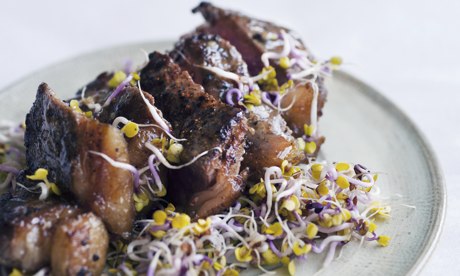 Sirloin with miso and togarashi.
Photograph: Jonathan Lovekin for Observer Food Monthly
There is more than one form of togarashi seasoning. The most popular is a
blend of chilli powder, orange peel, Szechuan pepper, sesame and ginger. Other
blends come with dried lemon in them.
Sirloin with miso and togarashi.
Photograph: Jonathan Lovekin for Observer Food Monthly
There is more than one form of togarashi seasoning. The most popular is a
blend of chilli powder, orange peel, Szechuan pepper, sesame and ginger. Other
blends come with dried lemon in them.
Buy it for adding a light, aromatic heat to steaks, aubergines and chicken.
Get it from Japanese grocers and the larger supermarkets.
Serves 2
sirloin steaks 2
radish sprouts to serve
for the dressing:
mirin 120ml
yellow miso paste 2 level tbsp
sugar 1 tbsp
togarashi seasoning a half to 1 tsp
Warm a little oil and a thick slice of butter in a shallow, heavy-based pan. Season the steaks and add them to the pan once the butter starts sizzling. As they brown on the surface, almost continually spoon the butter and oil over them, turning once the underside is done to your liking.
Pour the mirin into a saucepan and warm it gently. Stir in the miso paste and the sugar. When they have dissolved, remove from the heat and stir in the togarashi seasoning.
When the steak is ready, pour the dressing into the pan, roll the steak over in it, then set aside to rest for five minutes before slicing and serving with the radish sprouts.
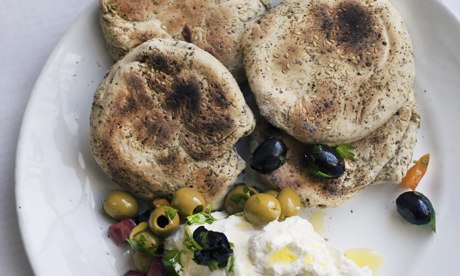 Za'atar bread. Photograph: Jonathan
Lovekin for Observer Food Monthly
Za'atar, the Middle Eastern spice mixture made, at its most basic, from dried
thyme, oregano, salt and sesame seeds, is often eaten with flatbreads and
labneh, the strained yoghurt. Mixed with olive oil, when it is known as
za'atar-wu-zayt, the mixture is then spread on the outside of flatbreads before
baking. Here, I incorporate it into the breads themselves, making them
particularly fragrant. I have also used this spice mix with grilled lamb,
scattering it over the surface of the oiled meat during grilling.
Za'atar bread. Photograph: Jonathan
Lovekin for Observer Food Monthly
Za'atar, the Middle Eastern spice mixture made, at its most basic, from dried
thyme, oregano, salt and sesame seeds, is often eaten with flatbreads and
labneh, the strained yoghurt. Mixed with olive oil, when it is known as
za'atar-wu-zayt, the mixture is then spread on the outside of flatbreads before
baking. Here, I incorporate it into the breads themselves, making them
particularly fragrant. I have also used this spice mix with grilled lamb,
scattering it over the surface of the oiled meat during grilling.
Buy it for introducing a warm, deeply herbal note to baking and to grilled foods.
Buy it from Lebanese and Middle Eastern grocers. Some large supermarkets.
Makes 8
for the bread:
strong, white bread flour 250g
salt 5g
za'atar 3 tbsp
instant yeast 7g
unsalted butter 15g
water about 150ml
To serve:
labneh or strained yoghurt
mixed olives
extra virgin olive oil
Put the flour in a large, warm mixing bowl and add the salt, za'atar and the yeast. Add the butter and most of the water, then mix with your hands to bring the mixture together. Gradually add the remaining water until all the flour is mixed in.
Put the dough on a lightly floured board and knead for 5-10 minutes. When the dough feels smooth and silky, place it back in the mixing bowl, cover it with a warm tea towel and leave it in a warm place to rise for at least an hour until it has doubled in size.
Tip the dough on to a floured surface, fold repeatedly until all the air is knocked out of it, then tear it into 8 equal pieces. Roll each piece into a ball then flatten them into discs about the size of a digestive biscuit and set aside.
Warm a dry non-stick frying pan over a moderate heat, place the bread discs in the pan, a few at a time, and cook for 10 minutes or so till they are nicely toasted and a little puffed.
Serve the warm breads with the labneh and olives, trickling a little olive oil over the labneh at the table.
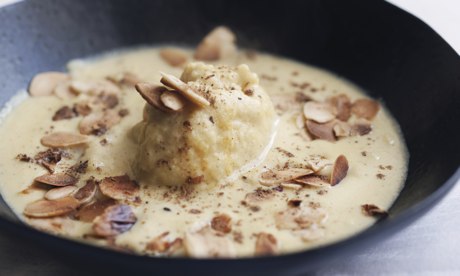 Cauliflower soup with ras el hanout.
Photograph: Jonathan Lovekin for Observer Food Monthly
Ras el hanout is a mild, gently flavoured blend of spices from north Africa
that can include cinnamon, cumin, cloves, nutmeg, galangal and rose petals.
Cauliflower soup with ras el hanout.
Photograph: Jonathan Lovekin for Observer Food Monthly
Ras el hanout is a mild, gently flavoured blend of spices from north Africa
that can include cinnamon, cumin, cloves, nutmeg, galangal and rose petals.
Buy it for stirring into rice, spicing couscous and mograbia and adding to tagines and casseroles.
Buy it from major supermarkets, Middle Eastern and north African grocers or online.
Serves 4-6
cauliflower 900g
milk 1 litre
butter 50g
ras el hanout 2 tsp
flaked almonds 100g
Remove the green leaves of the cauliflower, discarding anything with tough stalks, but keeping the smaller, tender leaves. Break the cauliflower into large florets then put them, with the reserved tender leaves, into a deep pan with the milk and a good pinch of salt.
Bring the milk to the boil, then turn the heat down to a simmer and let the cauliflower cook for 15-20 minutes until it is tender. Remove the leaves and six fat florets and set aside, then continue cooking till the remaining cauliflower is quite soft.
Process the soft cauliflower and its milk in a blender or food processor with the butter till very smooth then return to the pan, scraping it out of the blender jug with a rubber spatula. Add the ras el hanout and a little salt and pepper to taste.
In a shallow non-stick pan, toast the flaked almonds till golden. Warm the reserved cauliflower florets in the soup for a couple of minutes then ladle into bowls, a large floret and a ladle of soup in each, and add a light dusting of ras el hanout and a scattering of hot flaked almonds over the surface.
Some of these are available from high-street supermarkets, others from ethnic food shops and almost all are available online. They are all well established within their own cuisines, but haven't, till now, been easy to find in UK shops. Many of them may be already in regular use in your kitchen. But all are recent additions to my cooking that I believe deserve a much wider audience.
Fried ginger chicken, yuzu dip
The yuzu is small Japanese citrus fruit with a flavour that is often described as poised between lemon and grapefruit. Whatever, it is a delightful, sweet-sharp fruit whose juice is sold here in bottles. Occasionally you may find fresh fruit in Japanese food centres. It is my tip for the most likely ingredient to become ubiquitous over the next few years. And that will suit me just fine.Buy it for sharpening up a marinade; adding a deep citrus flavour to soy sauce-based dips for tempura or sushi.
Serves 2
for the marinade:
light soy sauce 75ml
mirin 125ml
fresh ginger grated, 3 tbsp
chicken drumsticks 6
ginger a thumb-sized knob
rice flour 6 tbsp
for the dipping sauce:
dark soy sauce 2tbsp
yuzu juice 2 tbsp
oil for deep frying
Pour the light soy sauce into a sealable plastic bag, add the mirin and the freshly grated ginger.
Remove the skin from the drumsticks and slice the flesh from top to bottom to reveal the bone. Carefully cut the meat away from the bone in one piece and drop into the bag of marinade. Seal the bag and leave the chicken to soak in the seasoned soy and mirin for an hour or more. Overnight won't hurt.
Peel the thumb of ginger and cut into matchstick-size strips. Season the rice flour with salt and a little black pepper and spread it thickly on a plate or shallow bowl. Warm the oil to 180C.
Remove the chicken from its marinade and drop each piece into the seasoned rice flour, then lower carefully into the hot oil. Fry for 4 or 5 minutes until the outside is pale amber and lightly crisp. It is best not to overcrowd the pan, so cook them in two batches, and drain each on kitchen paper.
Fry the shredded ginger till golden and remove with a draining spoon. In a small bowl, mix the dark soy sauce and the yuzu juice together. Give the chicken a last quick fry to crisp it then serve with coriander leaves and the dipping sauce.
Butternut squash and coconut stew with galangal
 Butternut squash and coconut stew with
galangal. Photograph: Jonathan Lovekin for Observer Food Monthly
Galangal looks a little like ginger, but tastes very different, having none
of the root's citrus notes. Paler, smoother and often with pink tinges to its
plump ivory rhizomes, galangal is used in Vietnamese, Thai and Indonesian
cooking.
Butternut squash and coconut stew with
galangal. Photograph: Jonathan Lovekin for Observer Food Monthly
Galangal looks a little like ginger, but tastes very different, having none
of the root's citrus notes. Paler, smoother and often with pink tinges to its
plump ivory rhizomes, galangal is used in Vietnamese, Thai and Indonesian
cooking.Buy it for adding to a Vietnamese curry; including in a marinade for beef or pork; or for clear fish soups with crab or prawns.
Get it from Chinese and south-east Asian food shops and some of the larger mainstream supermarkets.
Serves 4-6
butternut squash 600g
groundnut oil a little
coconut milk 400ml
stock 500ml
galangal peeled and grated 3tbsp
lime juice of ½
spring onions 3
assorted Asian greens 3 large handfuls
Thai basil a small handful
coriander a small handful
Peel the squash, discard any seeds and fibres and cut the flesh into small dice roughly 2cm square. Warm a little oil in a frying pan, add the cubes of squash and cook until lightly browned on all sides.
Pour in the coconut milk and stock and bring to the boil, then lower the heat to a simmer. Add the grated galangal and the spring onions, season with salt and black pepper and continue cooking until the squash is tender and on the point of collapse.
Wash and roughly shred or tear the greens then push them down into the hot stew and leave them for 5 or 6 minutes over a low to moderate heat until they have wilted. Finish the stew by adding lime juice and salt to taste. You want a good balance of sour lime and sweet coconut with a little galangal in the background. Add the Thai basil and coriander just before serving.
Sirloin with miso and togarashi
 Sirloin with miso and togarashi.
Photograph: Jonathan Lovekin for Observer Food Monthly
There is more than one form of togarashi seasoning. The most popular is a
blend of chilli powder, orange peel, Szechuan pepper, sesame and ginger. Other
blends come with dried lemon in them.
Sirloin with miso and togarashi.
Photograph: Jonathan Lovekin for Observer Food Monthly
There is more than one form of togarashi seasoning. The most popular is a
blend of chilli powder, orange peel, Szechuan pepper, sesame and ginger. Other
blends come with dried lemon in them.Buy it for adding a light, aromatic heat to steaks, aubergines and chicken.
Get it from Japanese grocers and the larger supermarkets.
Serves 2
sirloin steaks 2
radish sprouts to serve
for the dressing:
mirin 120ml
yellow miso paste 2 level tbsp
sugar 1 tbsp
togarashi seasoning a half to 1 tsp
Warm a little oil and a thick slice of butter in a shallow, heavy-based pan. Season the steaks and add them to the pan once the butter starts sizzling. As they brown on the surface, almost continually spoon the butter and oil over them, turning once the underside is done to your liking.
Pour the mirin into a saucepan and warm it gently. Stir in the miso paste and the sugar. When they have dissolved, remove from the heat and stir in the togarashi seasoning.
When the steak is ready, pour the dressing into the pan, roll the steak over in it, then set aside to rest for five minutes before slicing and serving with the radish sprouts.
Za'atar bread
 Za'atar bread. Photograph: Jonathan
Lovekin for Observer Food Monthly
Za'atar, the Middle Eastern spice mixture made, at its most basic, from dried
thyme, oregano, salt and sesame seeds, is often eaten with flatbreads and
labneh, the strained yoghurt. Mixed with olive oil, when it is known as
za'atar-wu-zayt, the mixture is then spread on the outside of flatbreads before
baking. Here, I incorporate it into the breads themselves, making them
particularly fragrant. I have also used this spice mix with grilled lamb,
scattering it over the surface of the oiled meat during grilling.
Za'atar bread. Photograph: Jonathan
Lovekin for Observer Food Monthly
Za'atar, the Middle Eastern spice mixture made, at its most basic, from dried
thyme, oregano, salt and sesame seeds, is often eaten with flatbreads and
labneh, the strained yoghurt. Mixed with olive oil, when it is known as
za'atar-wu-zayt, the mixture is then spread on the outside of flatbreads before
baking. Here, I incorporate it into the breads themselves, making them
particularly fragrant. I have also used this spice mix with grilled lamb,
scattering it over the surface of the oiled meat during grilling.Buy it for introducing a warm, deeply herbal note to baking and to grilled foods.
Buy it from Lebanese and Middle Eastern grocers. Some large supermarkets.
Makes 8
for the bread:
strong, white bread flour 250g
salt 5g
za'atar 3 tbsp
instant yeast 7g
unsalted butter 15g
water about 150ml
To serve:
labneh or strained yoghurt
mixed olives
extra virgin olive oil
Put the flour in a large, warm mixing bowl and add the salt, za'atar and the yeast. Add the butter and most of the water, then mix with your hands to bring the mixture together. Gradually add the remaining water until all the flour is mixed in.
Put the dough on a lightly floured board and knead for 5-10 minutes. When the dough feels smooth and silky, place it back in the mixing bowl, cover it with a warm tea towel and leave it in a warm place to rise for at least an hour until it has doubled in size.
Tip the dough on to a floured surface, fold repeatedly until all the air is knocked out of it, then tear it into 8 equal pieces. Roll each piece into a ball then flatten them into discs about the size of a digestive biscuit and set aside.
Warm a dry non-stick frying pan over a moderate heat, place the bread discs in the pan, a few at a time, and cook for 10 minutes or so till they are nicely toasted and a little puffed.
Serve the warm breads with the labneh and olives, trickling a little olive oil over the labneh at the table.
Cauliflower soup with ras el hanout
 Cauliflower soup with ras el hanout.
Photograph: Jonathan Lovekin for Observer Food Monthly
Ras el hanout is a mild, gently flavoured blend of spices from north Africa
that can include cinnamon, cumin, cloves, nutmeg, galangal and rose petals.
Cauliflower soup with ras el hanout.
Photograph: Jonathan Lovekin for Observer Food Monthly
Ras el hanout is a mild, gently flavoured blend of spices from north Africa
that can include cinnamon, cumin, cloves, nutmeg, galangal and rose petals.Buy it for stirring into rice, spicing couscous and mograbia and adding to tagines and casseroles.
Buy it from major supermarkets, Middle Eastern and north African grocers or online.
Serves 4-6
cauliflower 900g
milk 1 litre
butter 50g
ras el hanout 2 tsp
flaked almonds 100g
Remove the green leaves of the cauliflower, discarding anything with tough stalks, but keeping the smaller, tender leaves. Break the cauliflower into large florets then put them, with the reserved tender leaves, into a deep pan with the milk and a good pinch of salt.
Bring the milk to the boil, then turn the heat down to a simmer and let the cauliflower cook for 15-20 minutes until it is tender. Remove the leaves and six fat florets and set aside, then continue cooking till the remaining cauliflower is quite soft.
Process the soft cauliflower and its milk in a blender or food processor with the butter till very smooth then return to the pan, scraping it out of the blender jug with a rubber spatula. Add the ras el hanout and a little salt and pepper to taste.
In a shallow non-stick pan, toast the flaked almonds till golden. Warm the reserved cauliflower florets in the soup for a couple of minutes then ladle into bowls, a large floret and a ladle of soup in each, and add a light dusting of ras el hanout and a scattering of hot flaked almonds over the surface.